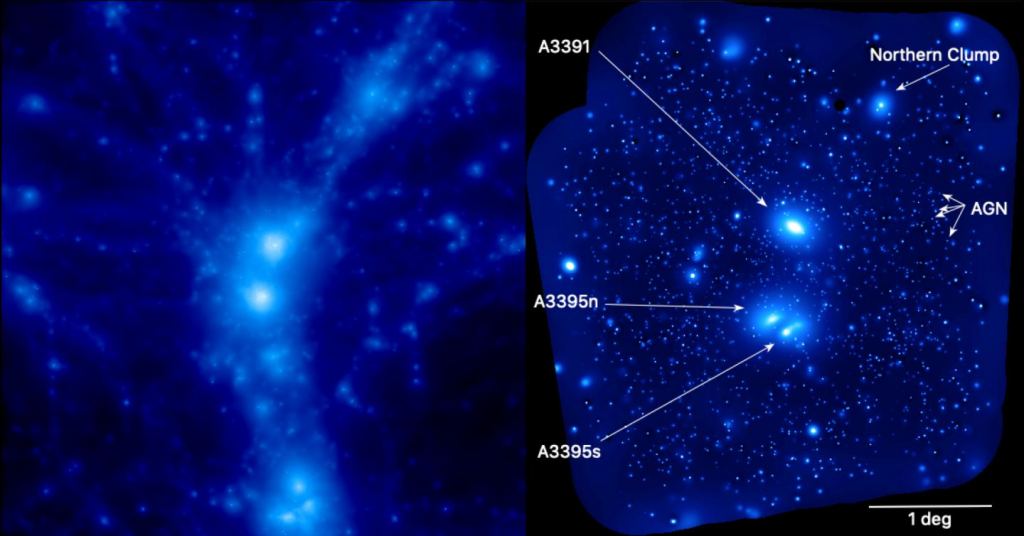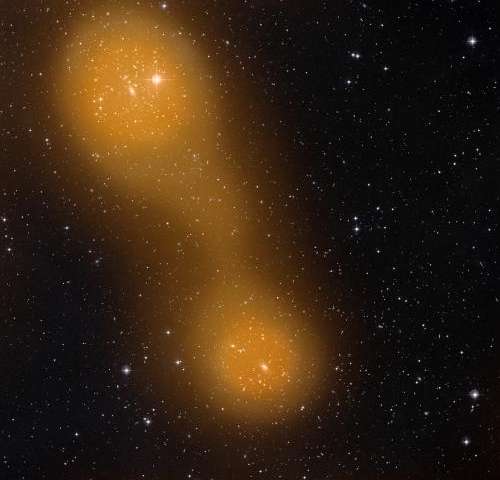Minute vibrating strings found in string theory are not the only ones that are of interest to physicists. The Standard Model of particle physics provides for a theory regarding a different type of string – this one is a string of very sparse gas strung over very long distances. In fact, the standard model predicts that a large percentage of “baryonic matter” (i.e. the type that makes up everything we can see and interact with) would be contained in these filaments. And now for the first time, scientists led by a team at the University of Bonn in Germany have detected one of these super long strings of gas.
The part of the Standard Model that predicts these strings starts with the hyper-inflationary period immediately following the Big Bang. According to the Standard Model, the only reason that there is literally anything in the universe at all is because the sphere that was the early post-Big Bang expansionary universe was slightly denser in some places than it was in others.

Credit: Reiprich et Al, Astronomy & Astrophysics
Those concentrations of matter gravitationally pulled other matter closer, eventually creating the first galaxies, stars, planets and everything else in the known universe. The Standard Model also predicted that those gravitational forces would also cause a tail of trailing particles that would show up as a kind of pathway between where the matter was originally located and where it was pulled.
However, so far it has been immensely difficult to detect these filaments because they are exceptionally sparse. Best estimates put the concentration of gaseous particles at 10 particles per cubic meter. That is a much lower concentration than what even our best vacuum machinery can artificially create.

Credit: ESA
Such a diluted stream of gas does not allow for many traditional methods of direct detection. However, the team searching for these filaments had access to a new instrument – eROSITA, an X-ray telescope run by the Max Planck Institute for Extraterrestrial Physics. For the first time ever eROSITA was able to pick up the x-rays emitted from these incredibly sparse gas clouds.
That gas cloud was observed while collecting data on the Abell 3391/95 set of three galaxy clusters. Not only did it pick up data from the gas clouds, but it showed the galaxies that comprise Abell and how the filament actually connects each galaxy to others in the cluster.
Credit: Reiprich / Astrophysics Research Center Youtube Channel
What’s even more impressive, the research team doesn’t think they have observed the full extent of the filament itself, even though the part they did detect was already more than 50 million light-years long. The sheer size of these filaments would help to explain why up to 50% of all interactable matter is theoretically still hidden in them.
eROSITA’s data does lend more credence to the idea that the filaments are indeed where that missing matter is hiding. But until more data is collected and these filaments are observed in more than one place, that new x-ray telescope, and the scientists who observe with it, will have many more strings to find.
Learn More:
Astronomy & Astrophysics – Original Paper
University of Bonn – Longest intergalactic gas filament discovered
Space.com – This intergalactic filament is 50 million light-years long, the longest we’ve ever seen
ScienceAlert – Astronomers Spot Elusive 50 Million-Light-Year Long Thread Tied to Cosmic Web
Lead Image Credit: Optical iamge of the Abell galaxy cluster where the x-ray work was done. Credit: Reiprich et all, Astronomy & Astrophysics
"gas" - Google News
December 25, 2020 at 02:04PM
https://ift.tt/37NTZ3O
A Single Filament of Gas Has Been Discovered That Stretches 50 Million Light-Years - Universe Today
"gas" - Google News
https://ift.tt/2LxAFvS
https://ift.tt/3fcD5NP
Bagikan Berita Ini















0 Response to "A Single Filament of Gas Has Been Discovered That Stretches 50 Million Light-Years - Universe Today"
Post a Comment